Contents
Market Overview
Macro Review
All eyes and ears this week were on the Fed’s FOMC and Chair Powell’s press briefing. The message stroke a hawkish tone pointing to a liftoff in March, potential faster path of monetary policy normalization, and earlier QT. As a result, expectations about the scale and pace of policy normalization repriced further, with five rate hikes in 2022 seemingly the base case now, although some analysts are calling for up to seven. In any case, a journey from the long-standing paradigm of massive and ever-increasing liquidity in DM to a less accommodative policy environment appears to have started. Investors would need to assess what challenges and opportunities that journey would entail. Predictably, markets are never enthusiastic about uncertainty/change, which manifested in an overall risk-off sentiment. Going forward, the challenge for the Fed and the other systemic central banks would be to orchestrate a continuation of an orderly managed transition to the new regime, one that markets should be able to navigate without too much stress after the initial repricing. The main risk is losing control of the narrative along the journey, which could trigger more stressful scenarios in global markets. There are all kinds of implications for EM in this environment. A hawkish Fed/tightening global financial conditions are headwinds to emerging markets, but many EM policymakers appear to have learned their lessons from previous similar episodes and as such, they are entering this one better prepared for the journey ahead. For example, a number of prudent EM central banks have pre-emptively started to normalize their monetary policy in anticipation of Fed tightening, shielding their currencies and economies to some extent from the effects of potential stronger USD and tightening financial conditions. This trend continued this week with hikes by Chile, Colombia and South Africa and a few others clearly signaling a strong hawkish bias amid still challenging inflation dynamics. Meanwhile, beyond the DM monetary policy outlook, global headlines continue to be dominated by the Russia-NATO standoff over Ukraine and the risks for the global economy of a potential military escalation. Given Russia’s position as the world’s largest energy supplier and the potential for significant U.S. sanctions on Russia in case of military conflict in Ukraine, energy/commodity markets appear most exposed to such a scenario. Some analysts estimated that in a worst-case “invasion scenario” global crude oil prices could increase between $5 and $20/bbl depending on the severity of the crisis, while natural gas prices in Europe could move up between €12 and €40/MWh. In the meantime, efforts to secure a peaceful de-escalation have intensified this week; the U.S. and NATO delivered their written responses to Russia’s security demands and the market will be eagerly awaiting clearer signals on the Kremlin’s reaction.
EM Credit Update
Emerging market sovereign credit ended the week down 0.3%, which was largely unchanged in spread terms. U.S. Treasuries were also almost unchanged at the 10yr point at 1.78%, after having reached 1.86% on Wednesday in the FOMC’s aftermath and Chair Powell’s remarks. The 30yr bond ended the week 1bp wider, while the 2yr was in focus again widening by 17bp to 1.17%. In EM sovereigns, Ethiopia, Ecuador and Ghana outperformed this week, while Belarus, Honduras and Tajikistan lagged.
The Week Ahead
Next week in DM is likely to be less eventful for markets with focus on U.S. January non-farm payrolls (NFPs) and Euro Area 4Q21 GDP growth. The BoE is expected to tighten by 25bp, while the RBA to signal the end of QE and rate hikes in 2022; In Canada, investor consensus expects CNB to hike as well, but the size of the hike is under discussion. In EM, focus will be on rate setting meetings in Brazil, Czechia and Egypt, as well as inflation for January in Turkey. Beyond economic data, investors will be awaiting any news/signals on President Putin’s reaction to the West’s security proposals and next steps in the geopolitical standoff over Ukraine.
Highlights from emerging markets discussed below include: No visible de-escalation of NATO-Russia tensions over Ukraine yet, but diplomatic efforts for peaceful management of security concerns continue on multiple fronts; Argentina and IMF move closer to Staff-level agreement; Sri Lanka’s government appears to be edging closer to re-engaging with the IMF over potential financial assistance program; Monetary policy tightening in Latin America continues amid elevated inflation, political risks and tightening global financial conditions; and Global emerging markets corporates in focus: Don’t mention the ‘S’ word.
Fixed Income
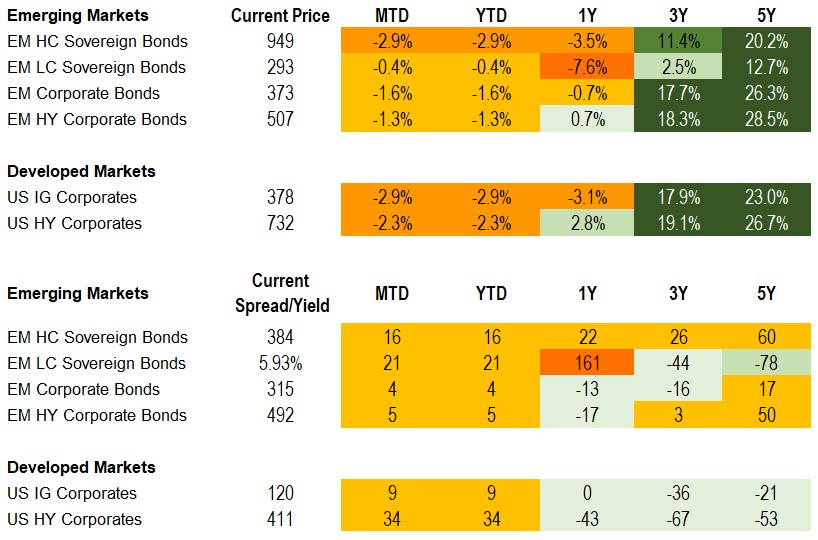
Equities
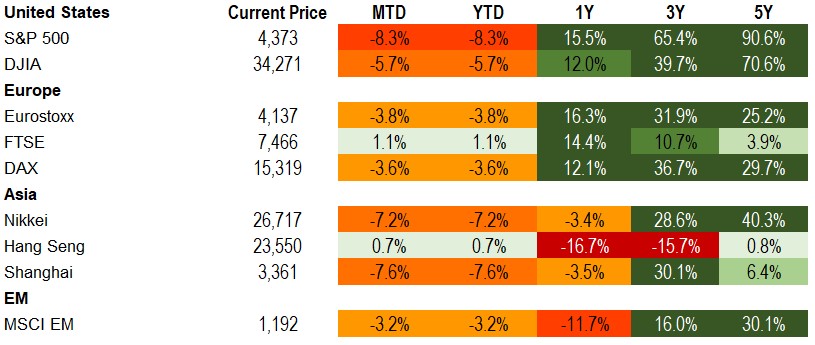
Commodities

Source for data tables: Bloomberg, JPMorgan, Gramercy. EM Fixed Income is represented by the following JPMorgan Indicies: EMBI Global, GBI-EM Global Diversified, CEMBI Broad Diversified and CEMBI Broad High Yield. DM Fixed Income is represented by the JPMorgan JULI Total Return Index and Domestic High Yield Index. Fixed Income, Equity and Commodity data is as of January 28, 2022 (mid-afternoon).
Emerging Markets Weekly Highlights
No visible de-escalation of NATO-Russia tensions over Ukraine yet, but diplomatic efforts for peaceful management of security concerns continue on multiple fronts
Event: The U.S. and NATO delivered their written responses to Russia’s security demands, as agreed last week. In the meantime, the “Normandy Four” summit, comprised of political advisors from Ukraine, Russia, France and Germany, tasked with implementing the Minsk peace agreements, met for the first time since January 2021. Additionally, French President Macron announced calls with Presidents Putin and Zelensky to discuss “paths to de-escalation”.
Gramercy Commentary: While the news flow continues to be dominated by risks of further escalation in tensions between Moscow and the West and potential Russian aggression against Ukraine, efforts to secure a peaceful de-escalation have also intensified this week. The key signpost to watch is the Kremlin’s assessment and President Putin’s reaction to the U.S. and NATO’s formal written response to Russia’s key security concerns. Meanwhile, Ukraine’s government and President Zelensky himself have made a strong concerted effort in recent days to reassure their own population and the international community that a “Russian invasion”, the main driver of market concerns at the moment, is not imminent and remains unlikely. Our view is that although escalatory rhetoric/dynamics in the coming weeks could put further pressure on Russian/Ukrainian market assets and global risk sentiment, the underlying structural trends and incentives point toward ultimate peaceful “managed confrontation” between Russian and the West over geopolitics/security in the European theatre. We see Russian and Ukrainian sovereign assets as deeply oversold on fundamental credit basis, but a tangible relief rally would likely require clear signs of de-escalation by both sides, ideally supported by withdrawal of Russian troops from Ukraine’s borders.
Argentina and IMF move closer to Staff-level agreement
Event: Argentina and the IMF announced a newly reached compromise on the fiscal path under an eventual program which allows for gradual fiscal consolidation and reduction of monetary financing, leaving room for increased spending on infrastructure, science and technology as well as social programs. This brings the government one step closer to a Staff Level agreement with the Fund. According to the government, this would translate into a primary deficit level of 2.5% of GDP this year and just below 2.0% of GDP next year. The fiscal effort along with a multi-pronged approach to the monetary framework would reportedly be executed under a 2.5 year long program with reimbursement of the roughly $4bn of payments already made on the outstanding arrangement plus the just over $1bn in debt service paid to the Fund this week and next in context of the recent progress. Meanwhile, the Fund upgraded Argentina’s 2022 growth forecast by 50bps to 3.0% in its January World Economic Outlook presented this week. Argentine bonds partially retraced this year’s losses on the news.
Gramercy Commentary: We see the progress on the fiscal trajectory and willingness of the authorities to avoid arrears with the Fund as positive and in line with our base case for an eventual deal. Negotiations will continue in the coming weeks with focus likely to turn to the domestic political scene as Congress returns and debates the underlying components of the newly agreed fiscal path. Minister Guzman’s statement of intent to close a deal by March, ahead of the $2.8bn payment, is also constructive albeit the timeline for completion and approvals remains tight amid low net FX reserves leaving open the possibility for arrears. In this scenario, we would see arrears as brief and temporary and resolved within the broader context of the agreement. Continued progress and an eventual deal should be supportive for asset prices. Thereafter, policy execution, FX reserve dynamics, and increasingly the opposition’s momentum ahead of the 2023 election will become key market drivers.
Sri Lanka’s government appears to be edging closer to re-engaging with the IMF over potential financial assistance program
Event: Finance Minister, Basil Rajapaksa told the Financial Times this week that the authorities in Colombo are “negotiating with everybody” and “trying all options to avoid default”.
Gramercy Commentary: Minister Rajapaksa’s comments are fully in line with Sri Lanka’s strategy to mobilize all possible resources to remain current on sovereign debt obligations, displaying extremely strong “wiliness to pay” amid significant economic difficulties exacerbated by the COVID-19 crisis over the last two years. However, the government has thus far resisted the idea of approaching the IMF for financial assistance in exchange of commitment to economic reforms. As the servicing of sizable external debt obligations that are looming over the coming years looks increasingly challenging amid dwindling FX liquidity onshore, a stretched-out recovery in Sri Lanka’s important tourism sector, and the overall macro environment, the government appears to have warmed to the idea of re-engaging with the Fund. We are encouraged by such signals, although only tentative for now, as we believe a scenario of market-friendly debt restructuring under the backings of an IMF program/reform commitments (a la Ecuador 2020) is the most desirable one from a market perspective and should unlock value in the sovereign bonds complex.
Monetary policy tightening in Latin America continues amid elevated inflation, political risks and tightening global financial conditions
Event: The Central Bank of Chile surprised markets by delivering 25 bps of extra monetary tightening this week (150 bps vs 125 bps consensus), hiking its policy rate to 5.5%; Colombia’s BanRep followed suit on Friday with a 100bps hike to 4.0%.
Gramercy Commentary: Policy makers at central banks in Latin America and across EM are facing a complex environment characterized by elevated domestic and global inflation and a U.S. Federal Reserve that has signaled a more hawkish bias going forward. In view of such headwinds, several pragmatic orthodox emerging market monetary authorities have already embarked on pre-emptive tightening cycles since 2021 that should restore FX-supportive real carry buffers once disinflation settles in. However, the global/emerging market inflation outlook remains uncertain at elevated levels, motivating some central banks to turn more aggressive with the pace and size of their policy tightening. Political risks are also prominent this year in Latin America where policymakers need to consider fiscal implications of recent political changes (in the case of Chile) and potential ones (in the case of Colombia and Brazil given forthcoming important elections in both countries). As such, investors in these emerging market issuers’ local debt are likely to face a tug-of-war between prudent monetary policy management and volatility triggered by global factors and the political cycle.
Global emerging markets corporates in focus: Don’t mention the ‘S’ word
Event: Russia-Ukraine tensions are once again in focus. Letters have been written and various meetings have been held. Negotiations are expected to continue, as the parties involved seek to reach a consensus. In the midst of these talks, some governments have suggested that sanctions may be imposed on Russia should there be an escalation of tensions. These actions may have implications for emerging market corporates.
Gramercy Commentary: It is not clear what particular combination of sanctions the relevant bodies may choose to impose if red lines are crossed. Some reports have suggested that the most punitive sanctions may not be imposed but U.S. authorities and others have said that all options are still on the table. The uncertainty around the current situation has already impacted the valuations of emerging market corporate bonds issued by entities in, or with exposure to, both Russia and Ukraine. It is no wonder then that there have been reports of talks with authorities about mitigating the impact of potential sanctions by giving foreign companies, and others exposed to Russia and/or Ukraine, sufficient time to address this. Such dialogue may prove important if sanctions are indeed imposed. For issuers facing the prospect of being placed on restricted lists, previous sanctions episodes may provide some insight into the possibility of mitigation – with at least two issuers, ownership changes and other commitments meant those issuers were no longer subject to the strictest sanctions. Separately, some bonds issued after the first set of sanctions were imposed in 2014 contain alternative currency clauses allowing for settlement in other currencies. There is also the much-discussed Russian banking messaging system, another potential sanctions mitigant. It is of course possible that the sanctions package chosen which will not need such mitigation. This may be the case if such restrictions limit access to foreign capital markets for more issuers, as currently applies to some of Russia’s largest banks. Pre-existing foreign currency-denominated securities have continued to be serviced, and as those sanctions have not barred those payments. In summary, uncertainties related to Russian and Ukrainian issuers show the importance of working closely with legal and compliance colleagues in seeking to abide by ever-changing rules applicable in emerging market investing.
Emerging Markets Technicals
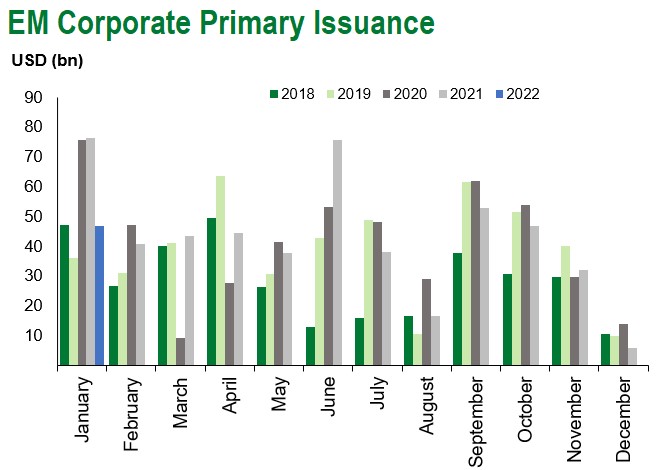
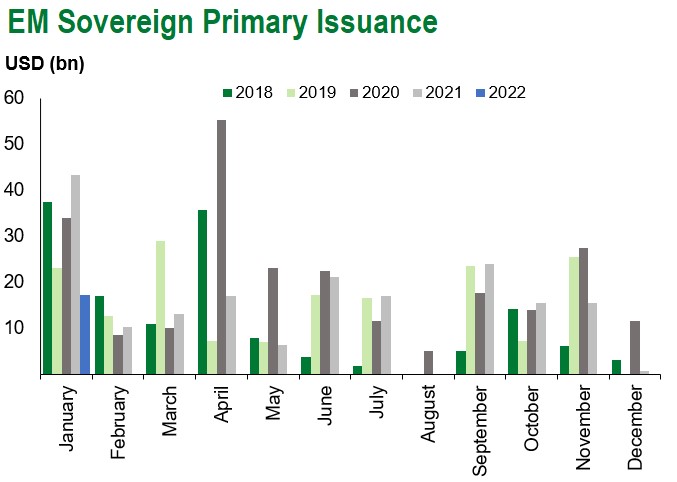
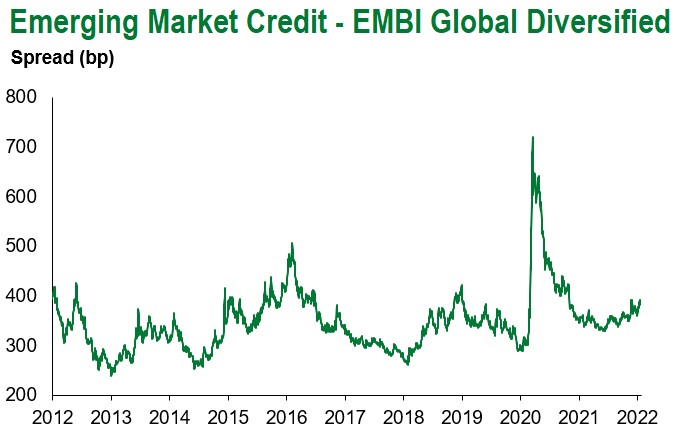
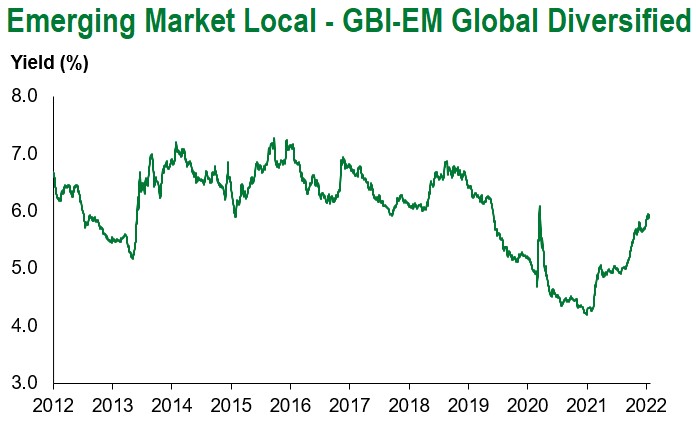
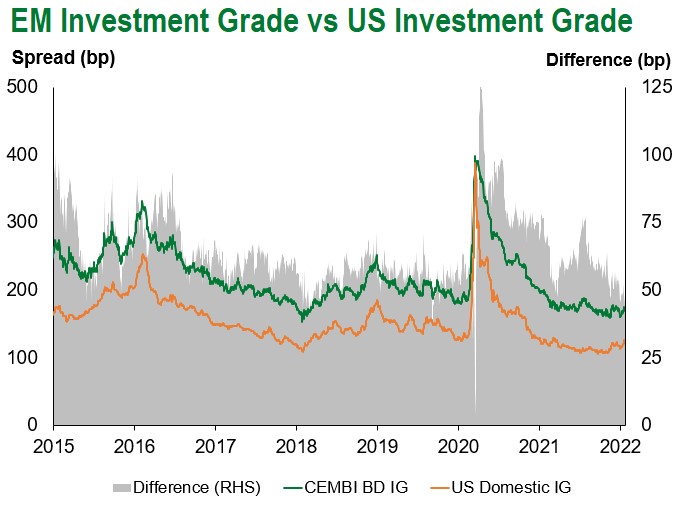
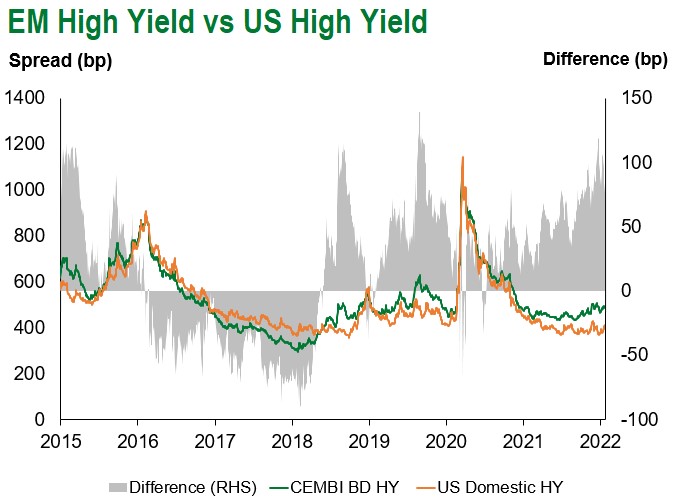
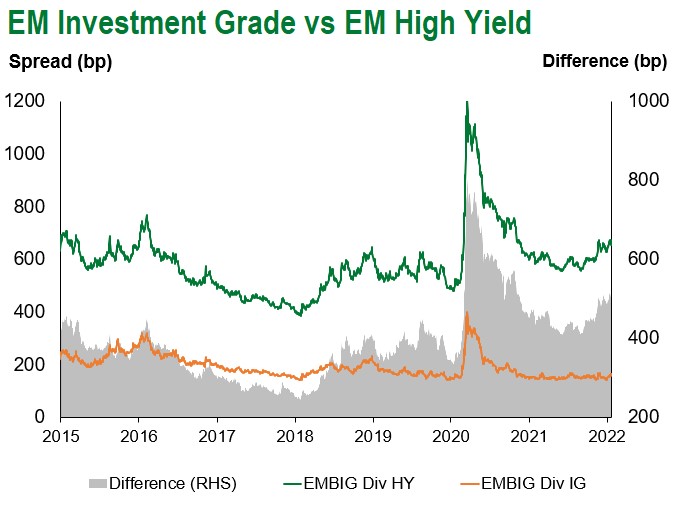
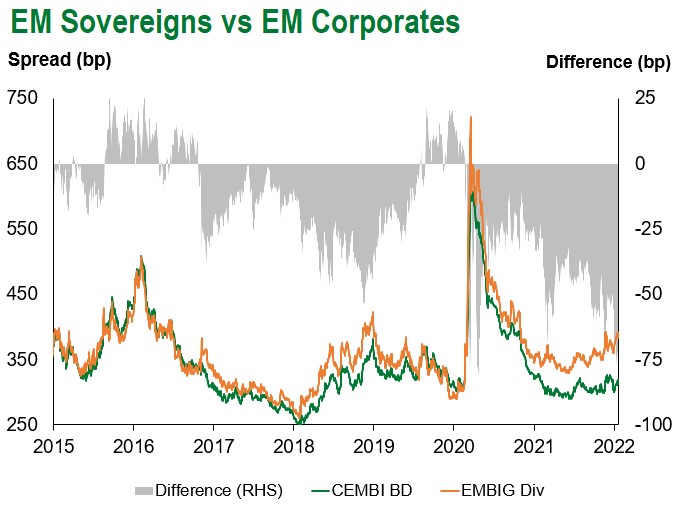
Emerging Markets Flows
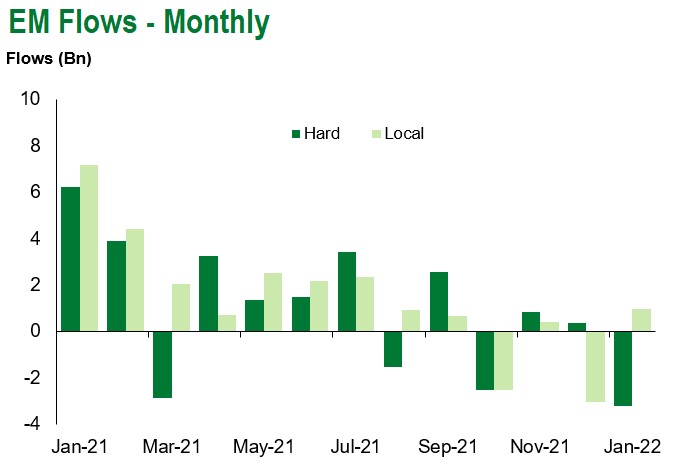
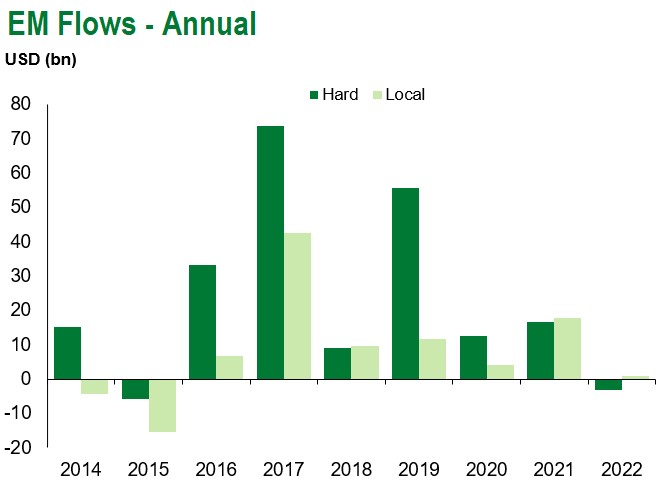
Source for graphs: Bloomberg, JPMorgan, Gramercy. As of January 28, 2022.
COVID Resources
Emerging Markets COVID-19 Case Summary
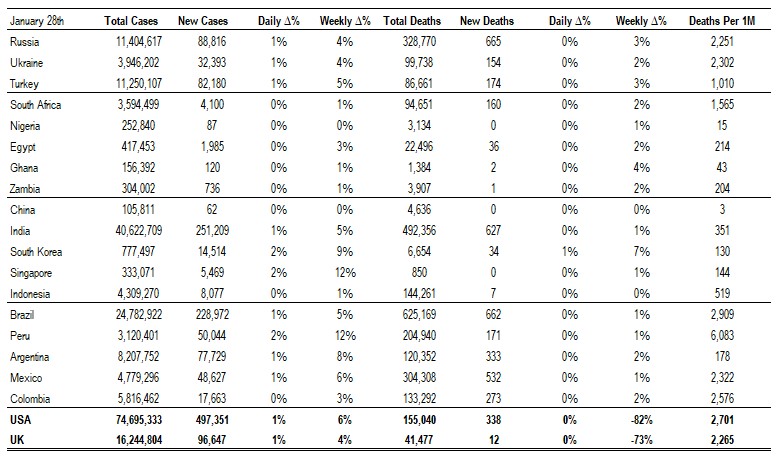
Source: Worldometer as of January 28, 2022.
Additional Crisis Resources:
Johns Hopkins COVID-19 Case Tracker
For questions, please contact:
Kathryn Exum, CFA ESG, Senior Vice President, Sovereign Research Analyst, [email protected]
Petar Atanasov, Senior Vice President, Sovereign Research Analyst, [email protected]
Tolu Alamutu, CFA, Senior Vice President, Corporate Research Analyst, [email protected]
James Barry, Vice President, Corporate Research Analyst, [email protected]
This document is for informational purposes only. The information presented is not intended to be relied upon as a forecast, research or investment advice, and is not a recommendation, offer or solicitation to buy or sell any securities or to adopt any investment strategy. Gramercy may have current investment positions in the securities or sovereigns mentioned above. The information and opinions contained in this paper are as of the date of initial publication, derived from proprietary and nonproprietary sources deemed by Gramercy to be reliable, are not necessarily all-inclusive and are not guaranteed as to accuracy. This paper may contain “forward-looking” information that is not purely historical in nature. Such information may include, among other things, projections and forecasts. There is no guarantee that any forecasts made will come to pass. Reliance upon information in this paper is at the sole discretion of the reader. You should not rely on this presentation as the basis upon which to make an investment decision. Investment involves risk. There can be no assurance that investment objectives will be achieved. Investors must be prepared to bear the risk of a total loss of their investment. These risks are often heightened for investments in emerging/developing markets or smaller capital markets. International investing involves risks, including risks related to foreign currency, limited liquidity, less government regulation, and the possibility of substantial volatility due to adverse political, economic or other developments. The information provided herein is neither tax nor legal advice. Investors should speak to their tax professional for specific information regarding their tax situation.